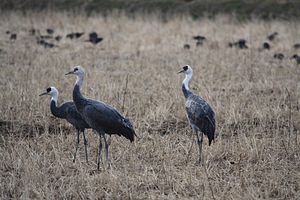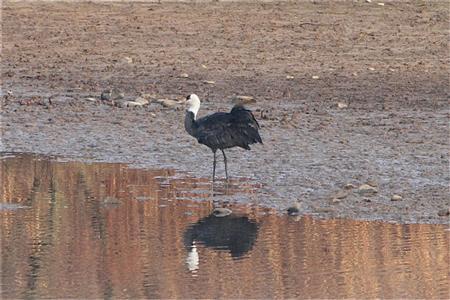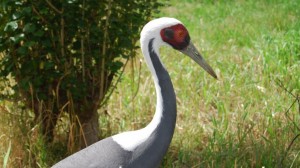
November 30, 2012
A strange brown crane has appeared in New Mexico. And been photographed.

The Wall Street Journal on November 29, 2012, reported the story:
Wildlife managers at one of the nation’s premiere bird-watching spots have a mystery on their hands.
A strange-looking bird with dark plumage showed up at the Bosque del Apache National Wildlife Refuge [in in southern Socorro County, New Mexico] earlier this month to join the tens of thousands of cranes and geese that spend the winter in the Rio Grande Valley.
The problem: No one knows exactly what kind of bird it is.
The debate has spread from the refuge’s fields and wetlands onto Facebook, where guesses have ranged from some kind of mutant to a Thanksgiving turkey disguised as a crane for self-preservation. Birding experts from New York to California continued studying photographs of the bird Thursday, spurring even more theories.
The refuge posted a photograph of the bird on its Facebook page this week, sparking dozens of comments. Aside from the disguised turkey and oil-slicked bird theories, some suggested it could be a hybridization between a crane and an emu or a trumpeter, which are native to South America.
It could be a sandhill crane that has come down with a feather-staining fungal infection.
Or maybe he — or she — has a genetic disorder that results in too much melanin production.
“It’s different. It’s got to be a hybrid-cross more than likely, but what, we don’t know,” Refuge Manager Aaron Mize told The Associated Press in a phone interview.
Members of the Cornell Lab of Ornithology’s Team Sapsucker — known as some of the best birders anywhere, they hold the U.S. record for finding the most bird species in 24 hours — say it’s a sandhill crane.
(Read more here.)
On April 7, 2011, a hooded crane (above, left) was photographed by Thomas D. Mangelsen standing in a cornfield with a sandhill crane northeast of Shady Bend Road and Interstate 80 south of Grand Island, Nebraska. At first, this crane was thought to be a melanistic sandhill crane. But an identification was forthcoming. It was said to be a hooded crane (Grus monacha).
“A rare hooded crane has been seen for the first time ever near Grand Island. The species of crane, which is smaller and darker than a sandhill crane, is native to Siberia and China, said Walter Wehtje of the Nebraska Crane Trust. He said it has likely been in the area a couple weeks,” noted the Grand Island Independent. “Each time the crane was spotted it was with a group of sandhill cranes. The hooded crane’s breeding ground is in far eastern Siberia, fairly close to the China border, Wehtje said. It then winters as far south as Korea and Japan. A hooded crane is smaller than a sandhill crane and has a dull black body, white neck and red patch on top of its head.”

Hooded crane (Grus monacha) photographed at Kyushu, Japan.
The archival photographs of Grus monacha show them with white necks and heads, and a little red on their heads.

An Asian hooded crane is seen at the Hiwassee Refuge in Tennessee in an undated handout photo by John Kuehnel.
Wikipedia reports, “In December 2011, a Hooded Crane was seen overwintering at the Hiwassee Refuge in southeastern Tennessee, well outside its normal range. In February 2012, one was seen at Goose Pond in southern Indiana, and is suspected to be the same bird, which may have migrated to North America by following sandhill cranes.

The Goose Pond, Indiana visitor, a hooded crane.
There are many species of cranes, some are brown. Has the correct species and possible immature or hybrid status been fully vetted for this New Mexico mystery bird? It merely appears to be an immature Sandhill Crane not a Hooded Crane.
(Hat tip to James Howell.)
About Loren Coleman
Loren Coleman is one of the world’s leading cryptozoologists, some say “the” leading living cryptozoologist. Certainly, he is acknowledged as the current living American researcher and writer who has most popularized cryptozoology in the late 20th and early 21st centuries.
Starting his fieldwork and investigations in 1960, after traveling and trekking extensively in pursuit of cryptozoological mysteries, Coleman began writing to share his experiences in 1969. An honorary member of Ivan T. Sanderson’s Society for the Investigation of the Unexplained in the 1970s, Coleman has been bestowed with similar honorary memberships of the North Idaho College Cryptozoology Club in 1983, and in subsequent years, that of the British Columbia Scientific Cryptozoology Club, CryptoSafari International, and other international organizations. He was also a Life Member and Benefactor of the International Society of Cryptozoology (now-defunct).
Loren Coleman’s daily blog, as a member of the Cryptomundo Team, served as an ongoing avenue of communication for the ever-growing body of cryptozoo news from 2005 through 2013. He returned as an infrequent contributor beginning Halloween week of 2015.
Coleman is the founder in 2003, and current director of the International Cryptozoology Museum in Portland, Maine.
Filed under Avian Mysteries, Breaking News, CryptoZoo News, Mothman, Winged Weirdies